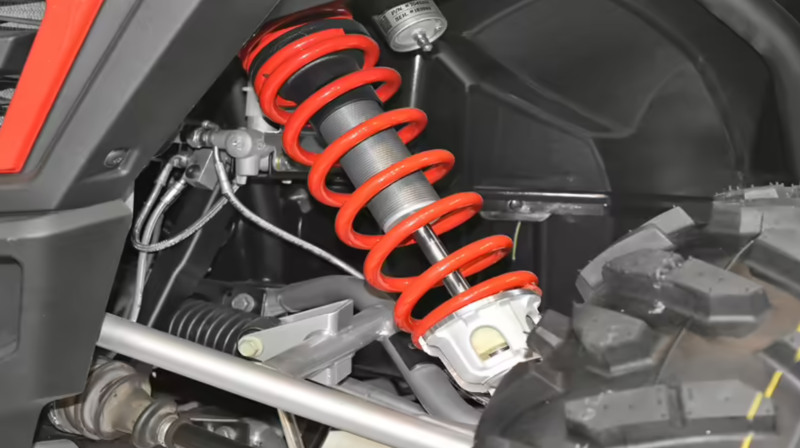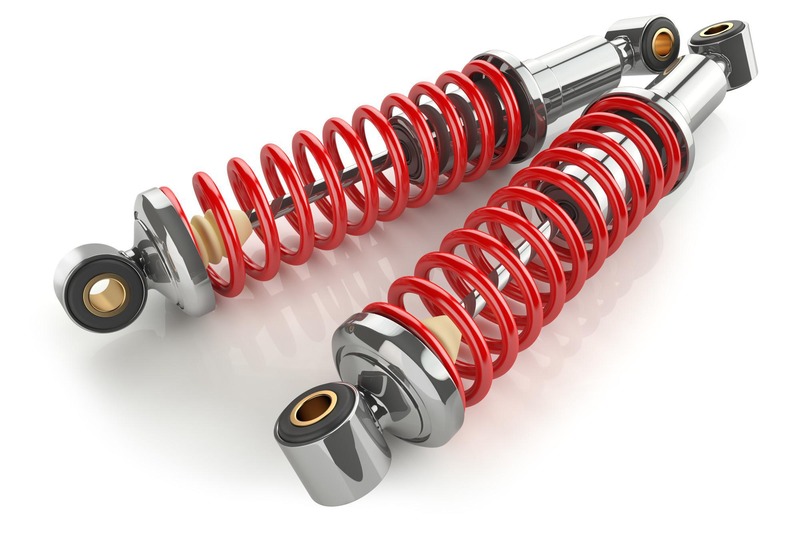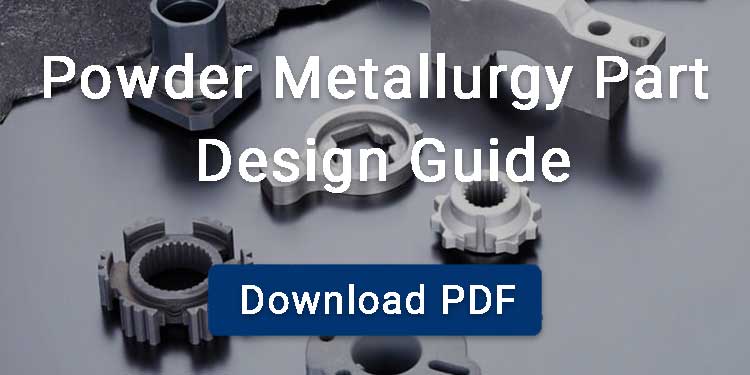Shock absorbers are devices in a vehicle’s suspension system that control spring movement and absorb energy from road impacts. They convert motion into heat through hydraulic fluid, reducing bouncing and keeping the tires in contact with the road. This improves ride comfort, handling, and braking stability.
Contents
How Shock Absorbers Developed with Time?
When we look back at the history of shock absorbers, the first shock absorber was actually designed for bicycles by French J.M.M. Truffault in 1898. Later on, in 1899, Edward V. Hartford used this spring fork design of shock absorber in his tricycle and got inspired by its results.
Both Truffault and Edward worked together to develop the shock absorbers and used them in curved-dash Oldsmobiles. They sent this to France for further testing, but only one company adopted the idea of installing a shock absorber in their vehicles. That was the big turning point, and from that time the shock absorbers have become an essential component of every comfortable vehicle.
How Do Shock Absorbers Work?
The shock absorbers usually operate on the principle of energy conversion from kinetic to thermal according to the law of conservation of energy. Whenever your car hits a bump, the suspension system works in the following four ways:
Compression and Rebound Damping
When we look at the structure of the shock absorber, it is actually a cylinder filled with oil and a moveable piston. Whenever the suspension of your vehicle compresses or extends, the piston inside the cylinder pushes the fluid. As a result, the suspension motion slows down. The resistance depends on how fast the piston moves, making the system velocity-sensitive. This process is known as damping, and it happens during both compression and rebound of the suspension.
Control of Spring Motion
The shock absorber plays a crucial role in reducing the motion of the spring. As soon as the spring reacts to bumps, its compression and rebound are controlled by the shock absorber by restricting how quickly it moves. This results in prevention of excessive bouncing and helps the suspension settle more quickly.
Tire Contact
Shock absorbers ensure that the tire of the vehicle remains in contact with the ground by managing spring motion. This helps maintain a smoother ride and improves vehicle control.
Safety and Braking Response
Shock absorbers work to provide better control during braking and off-road driving by slowing down the suspension movement during sudden jolts.
Shock Absorber Components
Each shock absorber contains several components, including the mount, bushing, coil spring, piston, piston rod, cylinder, and bolts. These shock absorber components work together to control suspension movement and enhance vehicle stability and comfort.
BLUE is a leading powder metallurgy manufacturer in China. We supply standard sintered shock absorber parts with no tooling cost. Browse and compare directly on our Shock Absorber Parts Shop—choose what fits, or request a match. If you can’t find the part you need, we also provide custom powder metallurgy part service.
Mount
The mount connects the shock absorber to the vehicle body and suspension system. It typically has upper and lower sections with holes or brackets for bushings and bolts, which secure the attachment and help absorb vibrations.
Bushing
Bushings are made up of rubber or urethane, which are placed at mounting points. The main function of bushings is to absorb vibration and reduce noise. In order to increase the durability of these bushings, metal components are incorporated in them.
Coil Spring
In certain suspension systems, the shock absorber is combined with a coil spring in a configuration known as a coilover, where the spring encases the shock absorber, jointly absorbing road impacts and supporting vehicle weight. In many vehicles, however, the spring and shock absorber function as separate components.
Piston and Piston Rod
Inside the shock absorber, the piston has small openings or valves that control how oil moves through it. This piston is responsible for controlling the damping action. The upward and downward movement of the piston within the cylinder is controlled by a piston rod.
Cylinder
This is the main component of the body of a shock absorber. It is responsible for holding the compression oil and piston, which moves inside to absorb and dissipate energy during suspension movement.
Bolts
Bolts are responsible for securely fastening the shock absorber with vehicle and suspension systems. In order to maintain a secure ride, the bolts must be tightened properly.

What Are the Different Types of Shock Absorbers?
Conventional Telescopic Shock Absorbers
These are the most commonly used shock absorbers in the front and rear suspension systems of a vehicle. These shock absorbers come with sealed designs eliminate the replacement of suspension oils. As a result, these are usually replaced when damaged, not repaired. These telescopic shock absorbers come in three different types:
- Twin-tube: Uses two chambers (oil and low-pressure gas) for better damping control.
- Mono-tube: Single large tube with separate gas chamber. These shock absorbers offer efficient heat dissipation via a larger surface area.
- Position-Sensitive Design (PSD): These telescopic shock absorbers feature grooves in the pressure tube to alter damping in different travel ranges.
Strut-Type Shock Absorbers
These are shock absorbers in which a spring is coiled around the suspension cylinder. These shock absorbers not only offer a smooth ride but also bear the vehicle load, providing support. They offer a compact design; that’s why they are used mostly in front wheels in medium or large vehicles.
These strut-type shock absorbers come in two types:
Strut Shock Absorber with Sealed Units
These shock absorbers come with sealed cylinders where fluid is not refilled or repaired, but the whole shock absorber is replaced when required.
Strut Shock Absorber with Repairable Units
Such shock absorbers come with repairable strut cartridges and are usually present in MacPherson strut suspension systems.
What Are Shock Absorbers Used For?
Automotive
In the automotive industry, Shock absorbers are used for vehicle stability and a controlled, comfortable ride. These are also being explored as a source of usable kinetic energy produced by damping.
Marine
In the marine industry, these shock absorbers play an important role in reducing vibration noise in marine environments. On ships and submarines, dampers are often installed along the propeller shafting system in order to limit underwater noise.
Aerospace
Shock absorbers play a key role in the landing gear system of aircraft by absorbing the impact forces during landing and converting them into thermal energy.
Structural Engineering
Shock absorbers are also used by civil engineers in the construction of buildings and bridges to save them from vibrations created by sudden earthquakes and traffic.

What Are the Signs of Worn Shock Absorber?
Increased Steering Wheel Vibration
If your shock absorber is damaged, you will experience a more vibrating steering wheel than usual while driving on rough roads. This vibration tends to worsen over time.
Uneven Tire Wear
When the shock absorbers are not working properly, it can lead to uneven wearing of your vehicle tires. As a result, some areas of the tire lose tread faster, resulting in bald spots or uneven tread patterns.
Forward Dipping When Braking
In case your front wheel shock absorbers are damaged, you may experience a forward dipping in the car’s front. This is a sign that your front wheel shock absorber is no longer controlling motion effectively.
Delayed Braking Response
A damaged shock absorber reduces the efficiency of the overall braking system and response time. This can cause delayed braking, taking longer than usual to stop the vehicle.
Poor Handling and Stability
The overall handling of your car will also be affected whenever your shock absorbers are worn. You feel unstable while swaying during turns or drifting slightly on straight roads.
Suspension Noise
Lastly, you may hear rattling or knocking sounds from the suspension area.
FAQ
How to Maintain your Shock Absorber?
Check for leaks, unusual tire wear, or reduced ride comfort regularly, and avoid overloading or aggressive driving on rough roads.
What Causes a Shock Absorber to Leak?
Leaks are usually caused by worn-out seals, corrosion, or physical damage that allows hydraulic fluid to escape.



